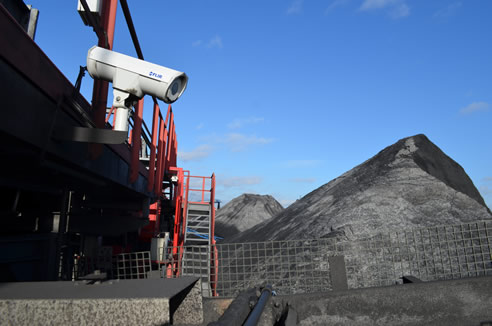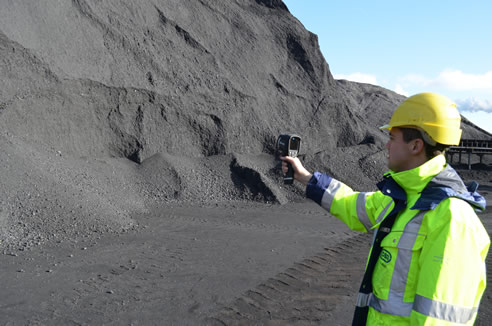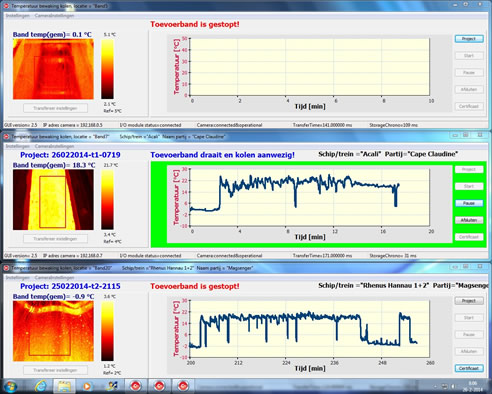NEWS ARTICLE ARCHIVESCoal Self-Combustion Detection with Thermal Cameras from FLIR The FLIR A310f is a highly sensitive and highspeed camera in an environmental housing.
FLIR cameras provide timely detection to
Versatile FLIR A310f and E6 cameras are When storing or loading large amounts of coal, self-combustion is a serious concern. Dutch bulk terminal company OBA is dealing with this risk every day. In order to ensure the safety of its coal storage and handling terminal, as well as to safeguard its investment, the company is using FLIR thermal imaging cameras to help monitor coal temperatures that signal potential self-combustion hazards before they have a chance to erupt. OBA is one of the leading dry bulk terminal companies in the ARA region (Amsterdam, Rotterdam, Antwerp). The company operates from two terminals in the port of Amsterdam, transferring and loading several commodities including coal, agricultural bulk goods, minerals, and biomass goods. With excellent rail and waterway connections via the North Sea and the Dutch hinterland, OBA offers multiple modes of shipping that include seagoing vessels, push barges, trains, and trucks. When driving up to the OBA terminal along the western Amsterdam port area, the massive piles of coal offer an impressive view. The storage and handling of coal amounts to roughly 80 percent of OBA's business, consisting of round-the-clock shipments to Germany, the Northeast of France, the UK, and the Netherlands. When coal is exposed to oxygen, its temperature rises and can ignite suddenly. It's no wonder that spontaneous combustion is a real worry around OBA's stockyards. Being such an extremely valuable product, it needs to be protected under a watchful eye 24/7. For some coal types, it's not the question of whether or not it will happen, it's a matter of when it will happen. "Self-combustion of coal is something we have to take into account every day," says Dick Meijer, Planner at OBA. "To prevent it from happening, we need to take the appropriate measures. More specifically, we send out an excavator or wheel loader to dig out and spread the suspected area. And we have dedicated combustion fighting equipment that allows us to compact the area and to release the oxygen out of the coal stack."
High responsiveness "In order to minimize those costs as much as possible, we were looking for a way to monitor the temperature of our coal stock before it's loaded onto the barges," comments Dick Meijer. "Thermal imaging turned out to be the perfect technology to do that. We already conduct weekly inspections via an external agency, but in 2013, we also invested in our own thermal imaging cameras from FLIR Systems to be sure that all the coal leaving our site has a temperature that is safe to be transported. The big advantage of thermal imaging compared to other technologies is that thermal imaging cameras can monitor entire areas of the coal stack. When the coal is on the conveyor belt, thermal imaging cameras allow us to read the entire coal mass temperature, not just the coal surface. Thanks to thermal imaging cameras, we can see if something goes wrong and immediately take the appropriate measures."
Temperature monitoring certificate
Camera set-up
The thermal video images are sent over IP to a central control room where they are continuously monitored. Operators make use of a proprietary software system that offers intuitive color codes to communicate about the real-time status of the coal loads. Code green means the coals are below a dangerous temperature and there is no danger for self-combustion. Yellow means the temperature is rising. In practice, this usually means temperatures are between 40°C and 50°C. When that occurs, OBA takes preventive measures, such as digging out and spreading the coals. Code red means that temperatures are above 55°C, prompting an alert that forces the conveyor to stop, preventing coals with excessive temperatures from being loaded.
Measuring in tough conditions
Quick temperature scans on site Meijer explains that the FLIR E6 is an intuitive, valuable tool for operators to have at their side to quickly spot where something has gone wrong. "When we receive a code yellow in the control room, we use the E6 to go up there and see with our own eyes what is going on. The camera is very robust and very easy to handle, even with gloves on." To put it simply, thermal imagers are a powerful solution to help keep resources and lives safe. |
 |
 |

